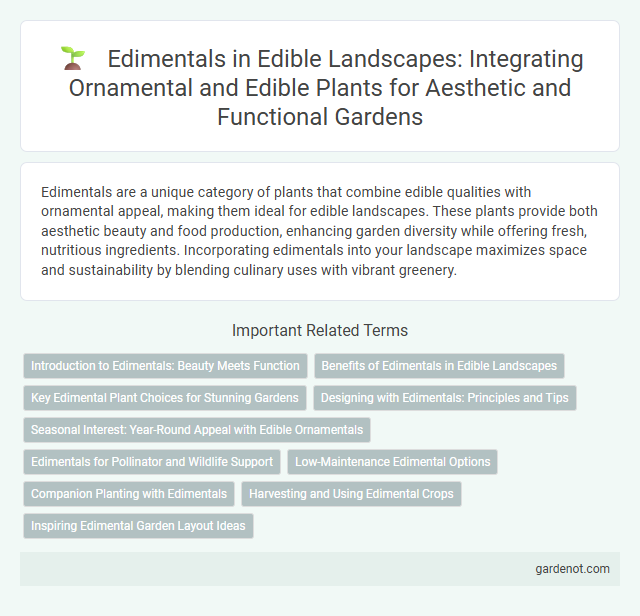Edimentals are a unique category of plants that combine edible qualities with ornamental appeal, making them ideal for edible landscapes. These plants provide both aesthetic beauty and food production, enhancing garden diversity while offering fresh, nutritious ingredients. Incorporating edimentals into your landscape maximizes space and sustainability by blending culinary uses with vibrant greenery.
Introduction to Edimentals: Beauty Meets Function
Edimentals merge aesthetic appeal with practical uses by integrating edible plants into landscapes, creating a harmonious blend of beauty and sustenance. This innovative approach enhances biodiversity, supports local ecosystems, and promotes sustainable gardening practices. By selecting species that offer visual charm alongside nutritional or medicinal value, edimentals transform traditional gardens into productive, eco-friendly environments.
Benefits of Edimentals in Edible Landscapes
Edimentals, comprising a diverse range of wild and cultivated edible plants, significantly enhance edible landscapes by improving biodiversity and ecosystem resilience. Their deep root systems enrich soil health while providing nutrient-dense, low-maintenance food sources that support sustainable agriculture. Incorporating edimentals in edible landscapes promotes foraging opportunities and conserves traditional plant varieties, contributing to food security and cultural heritage.
Key Edimental Plant Choices for Stunning Gardens
Key edimental plant choices for stunning gardens include perennial herbs like rosemary and thyme, which provide year-round flavor and visual appeal. Edible flowers such as nasturtiums and pansies add vibrant color while being perfect for salads and garnishes. Incorporating nutrient-dense leafy greens like kale and Swiss chard enhances both the beauty and functionality of edible landscapes.
Designing with Edimentals: Principles and Tips
Designing with Edimentals involves selecting a diverse range of edible plants that offer aesthetic appeal, seasonal variety, and nutritional benefits, creating a sustainable and visually engaging landscape. Incorporate principles such as layering plants for texture contrast, utilizing native or well-adapted species for resilience, and planning for successive harvests to maintain continuous productivity. Prioritize soil health and companion planting techniques to enhance growth, pest resistance, and overall ecosystem balance within the edible garden design.
Seasonal Interest: Year-Round Appeal with Edible Ornamentals
Edimentals combine seasonal interest and culinary use by showcasing edible ornamentals that provide year-round appeal in edible landscapes. Their vibrant foliage, flowers, and fruit change with the seasons, offering continuous aesthetic and gastronomic value from spring blossoms to winter-hardy greens. Integrating edibles like kale kaleidoscope, nasturtiums, and sorrel ensures dynamic textures and flavors throughout the year, enriching garden biodiversity and sustainability.
Edimentals for Pollinator and Wildlife Support
Edimentals, a unique category of edible plants, play a crucial role in supporting pollinators and wildlife by providing essential nectar, pollen, and habitat resources. Incorporating diverse Edimental species into edible landscapes enhances biodiversity, promotes ecosystem stability, and ensures food sources for bees, butterflies, and beneficial insects throughout growing seasons. These plants contribute to sustainable agriculture and garden productivity by fostering robust pollinator populations and encouraging natural pest control.
Low-Maintenance Edimental Options
Edimentals such as wild garlic, sorrel, and chives provide low-maintenance edible landscaping solutions that thrive with minimal care and adapt well to various soil conditions. These perennial herbs require little watering and pest control, making them sustainable choices for eco-friendly gardens. Incorporating edimentals enhances biodiversity while offering fresh, nutritious ingredients year-round.
Companion Planting with Edimentals
Companion planting with edimentals enhances biodiversity, improves soil health, and naturally deters pests through complementary plant interactions. Incorporating edimentals like comfrey, nasturtium, and borage can boost pollination and nutrient cycling in edible landscapes. This symbiotic planting strategy supports sustainable gardening by reducing reliance on chemical inputs while increasing garden productivity.
Harvesting and Using Edimental Crops
Edimentals, a unique blend of edible and ornamental plants, offer diverse harvesting opportunities throughout the growing season. Harvesting typically involves picking leaves, flowers, shoots, or roots when their flavors and textures are at their peak, ensuring maximum culinary value. Using edimental crops in salads, teas, or seasonal dishes enhances nutritional intake while promoting sustainable garden practices.
Inspiring Edimental Garden Layout Ideas
Edimentals showcase a diverse collection of edible plants that transform garden spaces into vibrant, sustainable ecosystems. Creative garden layouts incorporate layering techniques, combining perennials, herbs, and edible flowers to maximize yield and aesthetic appeal. Strategic placement of nutrient-rich plants like sea kale, sorrel, and lovage enhances soil health while providing year-round harvest opportunities.
Edimentals Infographic

 gardenot.com
gardenot.com